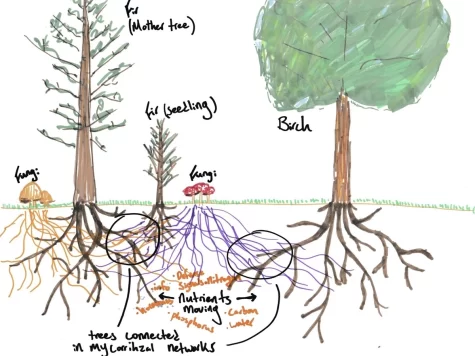The Hidden Communication Between Trees
Trees and other plants communicate and transfer supplies between each other.
May 9, 2023
Trees are mysterious in the sense of their silent and often ignored communication, involving seemingly invisible exchanges and unlikely partnerships. These plants have shown the ability to connect and communicate like social organisms, forming hidden networks and sending resources to each other. They do this by sending and receiving signals and nutrients often with the help of fungi, demonstrating fascinating methods of interaction and decisions on how to allocate resources.
Here’s how it works. Within the soil, mycorrhizal (or symbiotic) fungi interact with plant roots by growing connective lattices between root cells. They send out growing thread known as mycelium, which spreads through the soil to pick up water and nutrients such as phosphorus and nitrogen, which are all brought to the roots of their plants. These plants, in return, supply the fungi with sugar, the photosynthate, for their energy needs. Through this process, a mutually beneficial relationship is established and can be further utilized for communication. The fungal network, once developed, connects trees together, allowing one to send resources to another.
The most basic carriers for the calls and responses are protein and hormonal signals – biomolecules of importance in all organisms. They are transferred out by the sender and arrive at the receptors of target cells, triggering further exchange.
Some scientists are also looking into trees’ recognition of electrical pulses in a manner somewhat similar to that of neurons. In certain cases, signals can also be sent through the air, using volatile (easily evaporated) compounds.
Nevertheless, the use of a network of mycorrhizae is often considered the most quintessential of these communication methods. It is shown in many cases, one being a community of Douglas fir and paper birch trees in British Columbia. Here, the birches would transfer excess carbon food to the firs in summertime shade, and the evergreen firs would provide carbon to birches when they were bare of leaves and not photosynthesizing in the winter.
Plants also utilize the network at times of injury, shown through experiments with lab-grown conifers. When a large tree—considered a hub or stronghold in the network—was damaged, it would seemingly send defense signals to nearby ones. As a result, they would ready defense enzymes against potential threats. Secondly, heavily damaged trees would sometimes dump their resources into the fungal network for uptake by others, seemingly a last-ditch effort to prevent others from falling. In another community, foresters discovered some long-cut stumps still showing chlorophyll-green, functioning cells under their bark, indicating that they were kept alive by the network. A different example is the acacia tree, which releases ethylene gas through the air rather than fungi when damaged, a defense signal triggering nearby trees to pump a biomolecule called tannin to deter herbivores.
It is notable that in several of these scenarios, resources and signals were transferred between trees of different species, like the birch and fir, suggesting trees care for communal wellness. This idea, however, is controversial due to conflicting studies indicating selfish behavior. Mycorrhizae often seem to be involved for their own benefit, shown in the indifferent transfer of resources from a native grass to an invasive weed (Carey et al., 2004). Experiments suggest that some plants favor advancing their kin rather than communities, providing more resources to a network containing siblings (File et al., 2012) or responding more strongly to signals from them. After all, the desire to survive and benefit one’s species is hardwired into an organism. Perhaps discrepancies are due to differing genes (and traits) among species, resulting in varying responses to their surroundings, however an exact cause is yet to be determined.
The interactions between trees and fungi have significant implications for the future of ecology and forest-related industries. Scientists are looking into how shifting ecosystems as a result of climate change can bring plants’ networks to interact. The strategic protection of these networks or certain portions of them to strengthen forests and agriculture may also be crucial in times of human environmental harm, and even more uses are being developed.
Ultimately, trees and other plants are able to communicate and transfer supplies between each other utilizing chemical and potentially electrical signals through symbiotic fungi on an unseen level. Experiments show even more complicated interactions, such as recognizing kin and working with different species, and scientists are still working to fully understand all of these mechanisms. Among these interactions, it seems a key of forest and plant management may lie in their interconnectivity.

